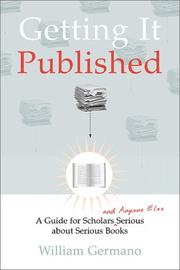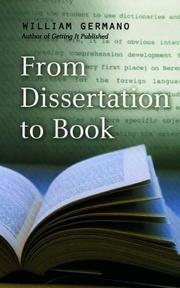| Listing 1 - 8 of 8 |
Sort by
|
Book
ISBN: 9780226062044 Year: 2013 Publisher: Chicago, Ill. University of Chicago Press
Abstract | Keywords | Export | Availability | Bookmark
 Loading...
Loading...Choose an application
- Reference Manager
- EndNote
- RefWorks (Direct export to RefWorks)
Graphics industry --- Science --- Editing. --- Authorship --- Academic writing. --- Marketing.

ISBN: 0226288447 0226288439 Year: 2001 Publisher: Chicago (Ill.) : University of Chicago press,
Abstract | Keywords | Export | Availability | Bookmark
 Loading...
Loading...Choose an application
- Reference Manager
- EndNote
- RefWorks (Direct export to RefWorks)

ISBN: 0226288463 0226288455 Year: 2005 Publisher: Chicago (Ill.) : University of Chicago press,
Abstract | Keywords | Export | Availability | Bookmark
 Loading...
Loading...Choose an application
- Reference Manager
- EndNote
- RefWorks (Direct export to RefWorks)
#SBIB:303H0 --- 655.28.022 --- Methoden in de sociale wetenschappen: algemeen --- Arbeidsfasen bij drukvoorbereiding. Pre-press. Kopijvoorbereiding. Copy-editing --- Academic writing. --- Authorship --- Editing. --- Marketing. --- Academic writing --- Editing --- Authors' markets --- Marketing of manuscripts (Authorship) --- Writers' markets --- Learned writing --- Scholarly writing --- Marketing
Book
ISBN: 9780226281407 9780226281377 022628137X 022628140X Year: 2016 Publisher: Chicago ; London : ©2016 The University of Chicago Press,
Abstract | Keywords | Export | Availability | Bookmark
 Loading...
Loading...Choose an application
- Reference Manager
- EndNote
- RefWorks (Direct export to RefWorks)
For more than a decade, writers have turned to William Germano for his insider's take on navigating the world of scholarly publishing. A professor, author, and thirty-year veteran of the book industry, Germano knows what editors want and what writers need to know to get their work published.Today there are more ways to publish than ever, and more challenges to traditional publishing. This ever-evolving landscape brings more confusion for authors trying to understand their options. The third edition of Getting It Published offers the clear, practicable guidance on choosing the best path to publication that has made it a trusted resource, now updated to include discussions of current best practices for submitting a proposal, of the advantages and drawbacks of digital publishing, and tips for authors publishing textbooks and in open-access environments.
Book
ISBN: 9780691192215 9780691192208 0691192219 0691192200 Year: 2022 Publisher: Princeton : Princeton University Press,
Abstract | Keywords | Export | Availability | Bookmark
 Loading...
Loading...Choose an application
- Reference Manager
- EndNote
- RefWorks (Direct export to RefWorks)
"The syllabus is one of the central documents of academic life, the one thing every teacher needs to write and every student needs to read. Most syllabi begin with a course description, a statement of what the course is about. But how do we get there ? How will our students get there? And where is there ? This book by William Germano and Kit Nicholls is a field guide to, and collegial chat concerning, this fundamental but often overlooked document. It describes how syllabi work and don't work, offers advice and encouragement to the professor trying to finish yet another syllabus, and reimagines our students' encounters with our syllabi by reconsidering our own relationship to them. Sampling syllabi from a range of disciplines across the sciences, social sciences, and humanities, Syllabus asks such questions as: what is a reading list, and what is it for ? how do we build human time into the semester's clocktime ? and can a syllabus be a living thing ? Germano and Nicholls argue that at its heart, a syllabus is not really about what students have to know, or what the instructor will do, but what the students will do. A syllabus designed around doing is not only a faster and more effective way to move students toward knowledge, they contend, but also, importantly, an invitation into a community of practice-one that includes the students, the instructor, and countless others who will enter the classrom through readings, images, designs, and theories. Reimagining the syllabus as a sort of constitution-a founding document that creates a community out of a group of disparate individuals-they show that a syllabus is, above all, a privilege and a responsibility, as one of the few forms of writing that can quite directly call others to act"--
Education, Higher --- Curriculum planning. --- College teaching. --- Curricula. --- Curriculum planning --- College teaching --- Education --- Teaching --- Curricula --- Curricula&delete& --- Philosophy
Book
ISBN: 9781844574469 1844574466 Year: 2013 Publisher: Houndmills, Basingstoke, Hampshire England ; New York Palgrave Macmillan, on behalf of the BFI
Abstract | Keywords | Export | Availability | Bookmark
 Loading...
Loading...Choose an application
- Reference Manager
- EndNote
- RefWorks (Direct export to RefWorks)
The tales of Hoffmann' is a unique and important film, both in the history of British cinema and in the history of interdisciplinary art-making. It is the first full-throttle presentation of an opera on screen: a Technicolor exploration of romance, fantasy, and failure, more danced than sung, all told without a single spoken word.
Book

ISBN: 9780231530736 Year: 2012 Publisher: New York, NY
Abstract | Keywords | Export | Availability | Bookmark
 Loading...
Loading...Choose an application
- Reference Manager
- EndNote
- RefWorks (Direct export to RefWorks)
Multi

ISBN: 9780231530736 9780231161152 Year: 2012 Publisher: New York, N.Y. Columbia University Press
Abstract | Keywords | Export | Availability | Bookmark
 Loading...
Loading...Choose an application
- Reference Manager
- EndNote
- RefWorks (Direct export to RefWorks)
| Listing 1 - 8 of 8 |
Sort by
|

 Search
Search Feedback
Feedback About UniCat
About UniCat  Help
Help News
News